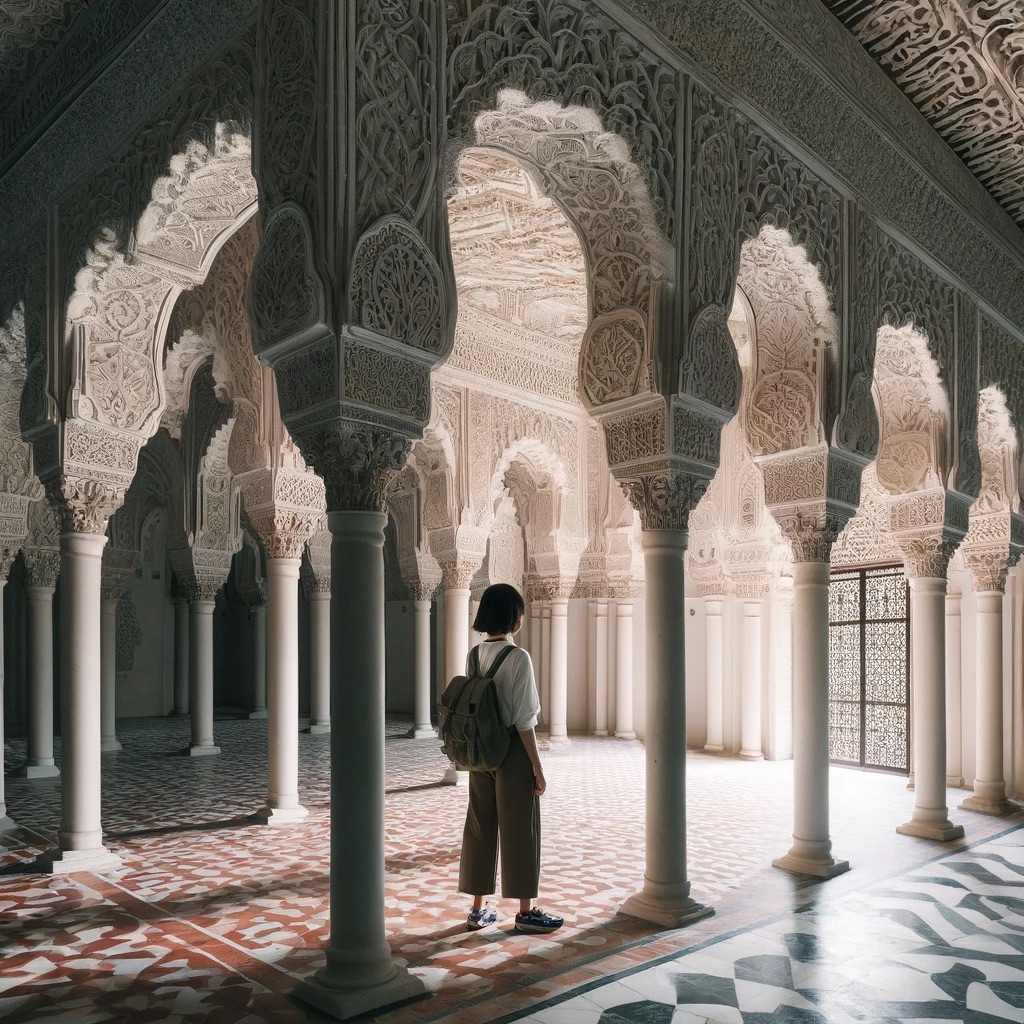ChatGPT:
Toledo is a historic city located in central Spain, approximately 70 kilometers south of Madrid. Perched on a hill overlooking the Tagus River, it serves as the capital of both the province of Toledo and the autonomous community of Castile-La Mancha. Known as the “City of Three Cultures,” Toledo has been a melting pot of Christian, Muslim, and Jewish influences, which is reflected in its rich architectural and cultural heritage.
The city’s Old Town is a UNESCO World Heritage Site, characterized by a labyrinth of narrow, winding streets and a diverse array of architectural styles, including Gothic, Mudéjar, Renaissance, and Baroque. Notable landmarks include:
Toledo has a storied past that dates back to Roman times. It became particularly significant during the Visigothic period when it was the capital of their kingdom in the 6th century. During the Middle Ages, the city was a prominent cultural and educational center where scholars of different faiths collaborated, leading to significant advancements in science, philosophy, and the arts.
Today, Toledo is also famous for its traditional crafts. The city continues its long-standing reputation for sword-making and damascene metalwork—a technique that inlays gold or silver into steel to create intricate patterns. Visitors often explore local workshops and purchase handcrafted souvenirs.
Toledo’s blend of historical significance, architectural beauty, and cultural richness makes it a captivating destination that offers a glimpse into Spain’s diverse heritage.
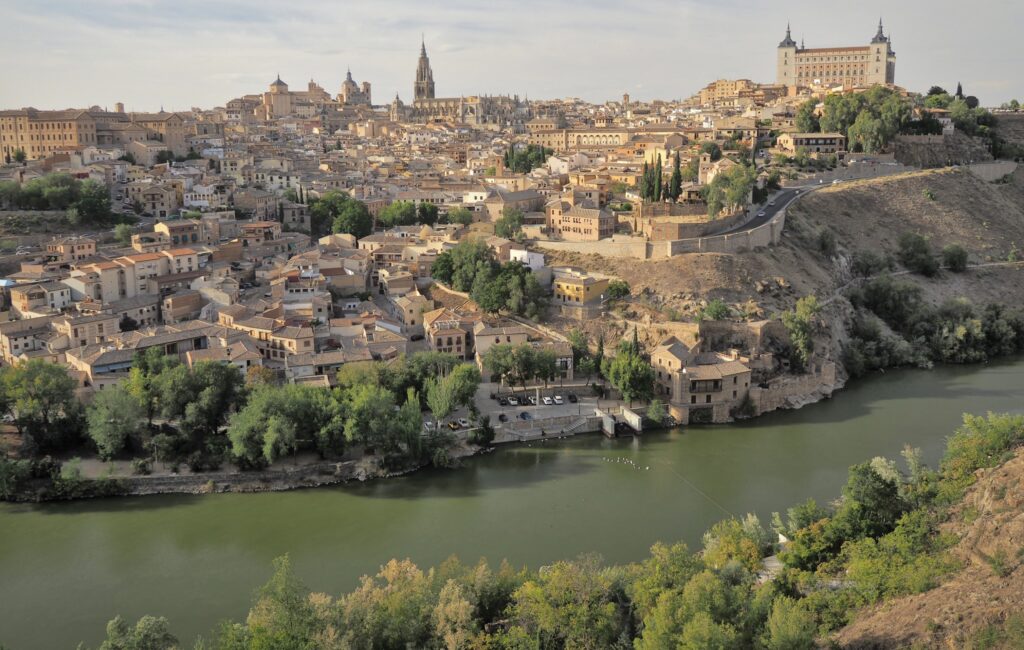
Origin and Early Settlement
Toledo’s origins can be traced back to the Bronze Age, with evidence of human habitation dating as far back as the 4th millennium BCE. Initially, it was a small Celtic-Iberian settlement inhabited by the Carpetani tribe. The city’s strategic location on a granite hill overlooking the Tagus River made it a natural fortress and a valuable asset for controlling the central Iberian Peninsula.
Roman Era
In 193 BCE, Toledo was conquered by the Roman Empire and became known as Toletum. Under Roman rule, it developed into an important administrative and commercial center within the province of Hispania Tarraconensis. The Romans built infrastructure such as roads, bridges, and aqueducts, remnants of which can still be seen today. The city’s urban layout began to take shape during this period, setting the foundation for its future development.
Visigothic Capital
Following the decline of the Roman Empire, Toledo fell under Visigothic control in the 5th century CE. In 576 CE, King Liuvigild declared Toledo the capital of the Visigothic Kingdom, marking the city’s rise as a political and religious center. The Visigoths established several important councils, known as the Councils of Toledo, which played a significant role in shaping early medieval Christian doctrine and consolidating the power of the monarchy and the Church.
Islamic Conquest and Rule
In 711 CE, Muslim forces led by Tariq ibn Ziyad began the conquest of the Iberian Peninsula. By 712 CE, Toledo was captured and became part of Al-Andalus, the Muslim-ruled territory in Iberia. Renamed Ṭulayṭulah, the city flourished under Islamic rule for over three centuries. It became a melting pot of cultures, where Muslims, Christians, and Jews coexisted relatively peacefully. The period saw advancements in science, medicine, philosophy, and the arts, with Toledo emerging as a center of learning and culture.
The Reconquista and Christian Rule
The tide turned in 1085 CE when King Alfonso VI of Castile captured Toledo during the Reconquista, the Christian effort to retake the Iberian Peninsula from Muslim rule. Recognizing the city’s cultural and intellectual wealth, Alfonso VI implemented policies of tolerance, allowing Muslims and Jews to continue practicing their religions. This period solidified Toledo’s reputation as the “City of Three Cultures,” where interfaith collaboration thrived.
Toledo School of Translators
Between the 12th and 13th centuries, Toledo became renowned for the Toledo School of Translators. This was not a formal institution but rather a group of scholars from different religious backgrounds who worked collaboratively to translate a vast body of knowledge from Arabic and Hebrew into Latin and later Castilian. Their work was instrumental in bringing ancient Greek and Arabic texts on philosophy, science, and medicine to the rest of Europe, significantly influencing the European Renaissance.
Late Medieval Period and Architectural Flourish
During the late medieval period, Toledo experienced significant architectural and cultural development. The construction of the Toledo Cathedral began in 1226 and was completed in 1493. This Gothic masterpiece symbolized the city’s religious importance and wealth. Other notable constructions included synagogues like the Synagogue of Santa María la Blanca and the El Tránsito Synagogue, which showcase the Mudéjar architectural style—a fusion of Christian and Islamic design elements.
Decline and the Move of the Capital
In 1561, King Philip II moved the Spanish court to Madrid, leading to a gradual decline in Toledo’s political influence. The city’s economy suffered as administrative functions and the aristocracy relocated. Despite this, Toledo remained a significant religious center and continued to contribute culturally, notably through artists like El Greco, who settled in the city and produced some of his most important works that captured Toledo’s unique atmosphere.
Modern History
The 19th century brought further challenges with the Peninsular War against Napoleon’s forces and internal conflicts like the Carlist Wars, which affected Toledo’s stability and economy. The city struggled to modernize, preserving much of its historical character while other Spanish cities industrialized.
During the Spanish Civil War (1936–1939), Toledo gained attention for the Siege of the Alcázar, where Nationalist forces held out against Republican troops. The event became a powerful symbol for Nationalists, and the Alcázar was later rebuilt and turned into a military academy and museum.
Preservation and UNESCO Recognition
In the latter half of the 20th century, efforts were made to preserve Toledo’s rich historical and cultural heritage. In 1986, UNESCO declared Toledo’s Old Town a World Heritage Site, recognizing its extensive monumental and cultural heritage as a testament to the coexistence of Christian, Muslim, and Jewish cultures.
Contemporary Development
Today, Toledo balances its historical legacy with modern development. The city has become a popular tourist destination, attracting visitors to its well-preserved medieval streets, historic buildings, and artisan shops. Traditional crafts such as sword-making and damascene metalwork continue to be significant economic activities.
The city also hosts various cultural events and festivals, like the Feast of Corpus Christi, which has been declared of International Tourist Interest. Educational institutions, including the University of Castilla-La Mancha, contribute to the city’s modern vibrancy.
Conclusion
Toledo’s origin and development are emblematic of Spain’s complex history. From a Roman municipium to the Visigothic capital, through periods of Islamic rule and Christian reconquest, Toledo has been a nexus of cultural and intellectual exchange. Its legacy as the “City of Three Cultures” reflects a unique period where collaboration across religious and cultural lines led to significant advancements in knowledge and the arts. Today, Toledo stands as a living museum, preserving the layers of its rich past while continuing to evolve in the modern era.
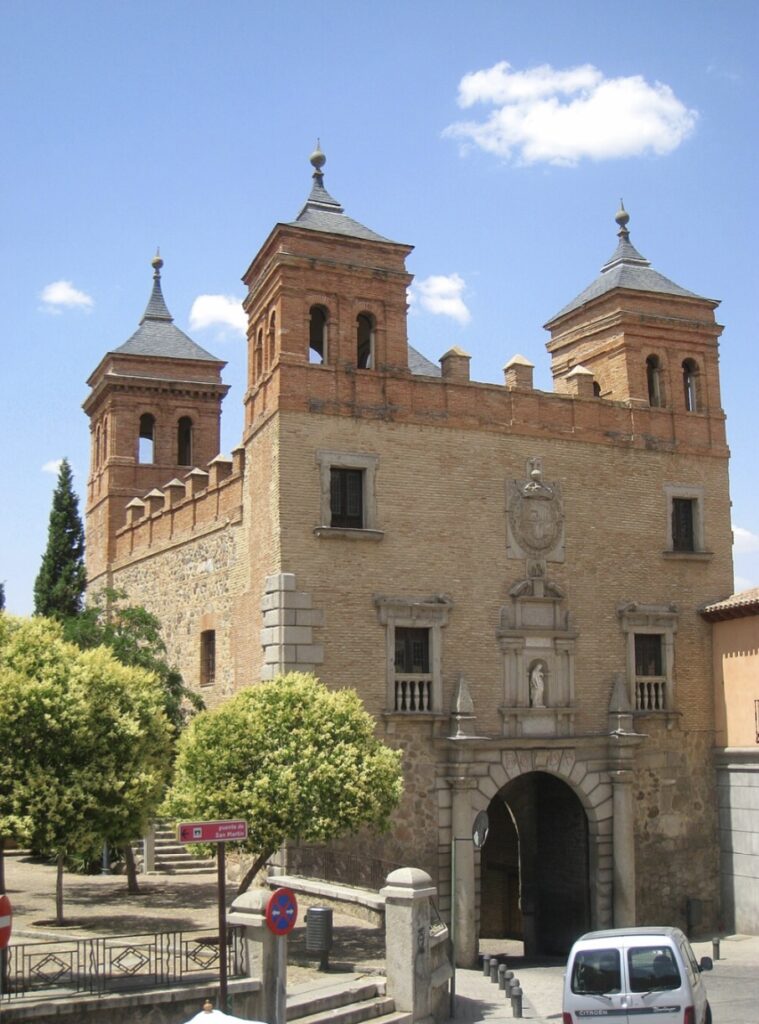
Toledo, often referred to as the “City of Three Cultures,” is rich in historical monuments and tourist attractions that reflect its diverse Christian, Muslim, and Jewish heritage. Below is a comprehensive list of the most significant sites to explore:
Religious Monuments
- Toledo Cathedral (Catedral Primada Santa María de Toledo)
- Description: A masterpiece of Gothic architecture, this cathedral is one of the most important in Spain. It houses an impressive collection of artworks, including paintings by El Greco, Goya, and Caravaggio.
- Highlights: The stunning choir stalls, the richly decorated sacristy, and the treasury featuring the famous gold Monstrance.
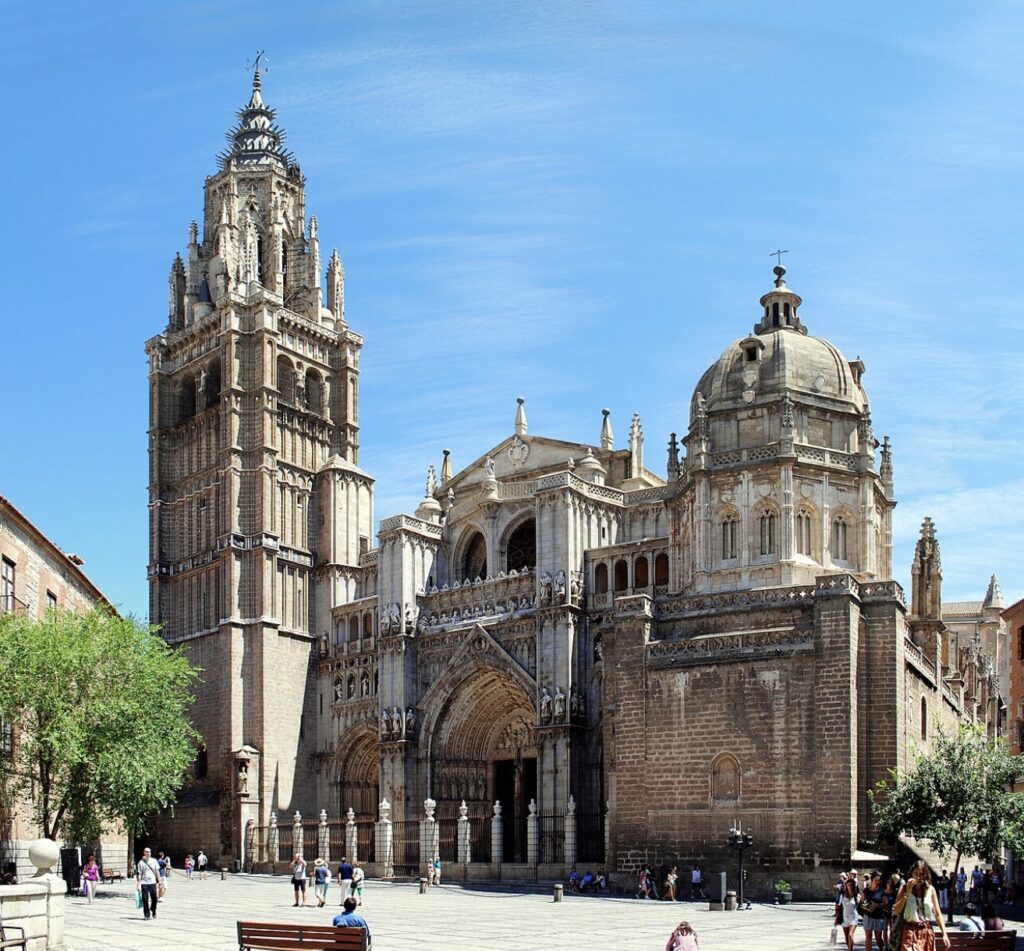
- Monastery of San Juan de los Reyes
- Description: Commissioned by King Ferdinand II and Queen Isabella I, this Franciscan monastery is a prime example of Isabelline Gothic architecture.
- Highlights: Ornate cloisters, intricate ceiling designs, and chains of Christian prisoners freed from Muslim captivity adorning the exterior.
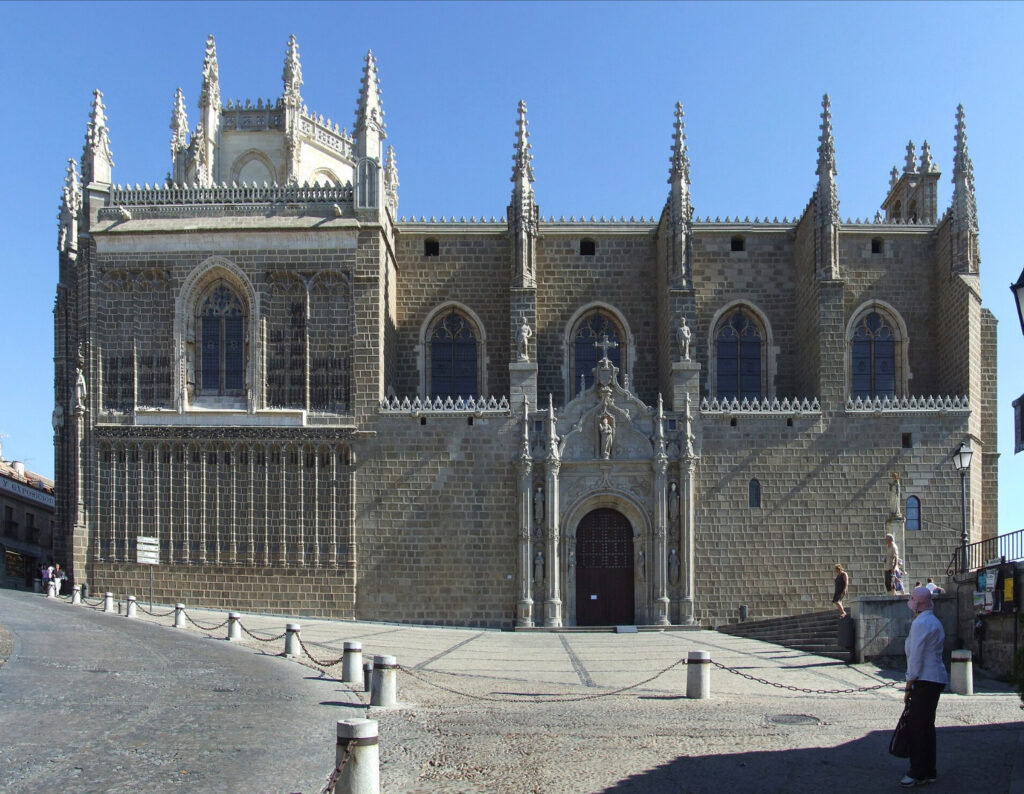
- Church of Santo Tomé
- Description: A 12th-century Mudéjar church known for housing El Greco’s masterpiece, “The Burial of the Count of Orgaz.”
- Highlights: The famous painting, beautiful Mudéjar tower, and Gothic elements.
- Iglesia de San Ildefonso (Church of San Ildefonso)
- Description: A Baroque church built by the Jesuits in the 17th century.
- Highlights: Twin towers offering panoramic views of the city and impressive Baroque interior.
- Mosque of Cristo de la Luz
- Description: Originally built in 999 CE as a mosque, it was later converted into a church. It’s one of the best-preserved examples of Moorish architecture in Toledo.
- Highlights: Horseshoe arches, original Islamic decorations, and a garden with remnants of the old city wall.
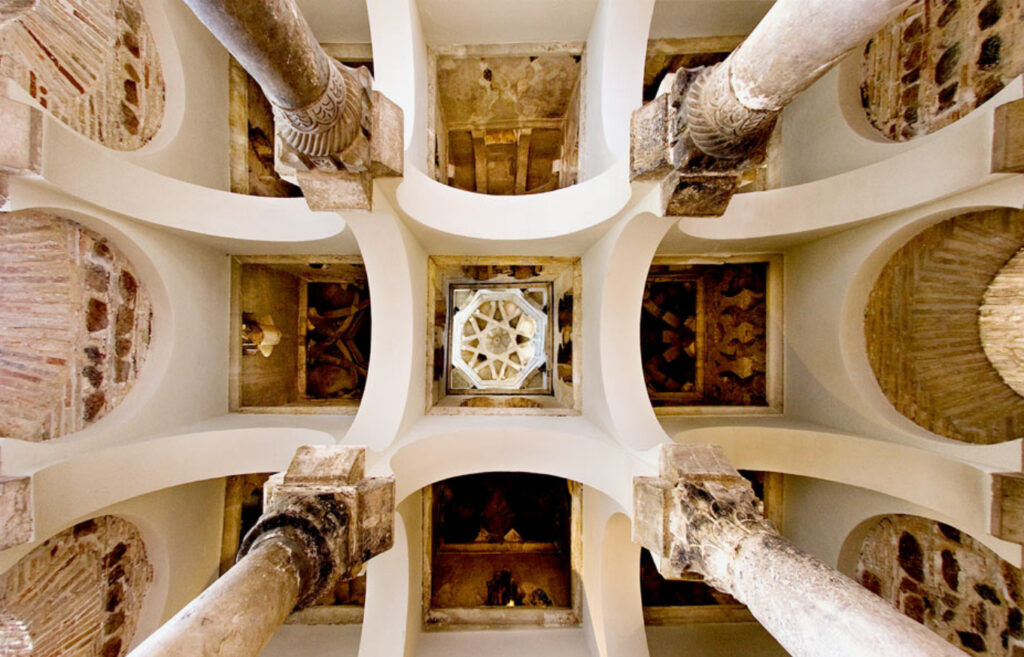
- Convent of Santa Isabel de los Reyes
- Description: A convent combining Mudéjar and Gothic architectural styles.
- Highlights: Peaceful cloisters, beautiful chapels, and a collection of religious art.
Jewish Heritage Sites
- Synagogue of Santa María la Blanca
- Description: Built in the 12th century, it’s one of the oldest synagogues in Europe, later converted into a church.
- Highlights: Striking white arches, Mudéjar architecture, and a symbol of interfaith history.
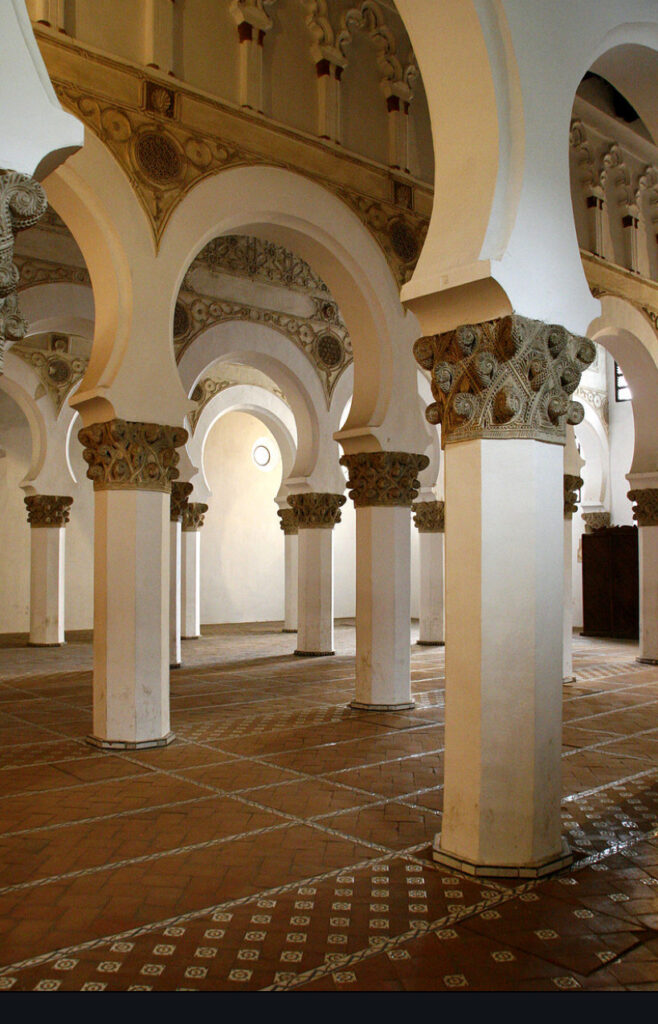
- El Tránsito Synagogue and Sephardic Museum
- Description: A 14th-century synagogue now housing the Sephardic Museum, dedicated to the history of Jewish culture in Spain.
- Highlights: Exquisite stucco work, Hebrew inscriptions, and artifacts illustrating Jewish life.
- Casa del Judío (House of the Jew)
- Description: A well-preserved medieval house located in the Jewish Quarter.
- Highlights: Traditional architecture and insights into the daily life of Toledo’s historical Jewish community.
Military and Fortifications
- Alcázar of Toledo
- Description: A stone fortification perched at the highest point of the city, historically used as a palace and military academy.
- Highlights: Houses the Army Museum, panoramic city views, and significant historical exhibits.
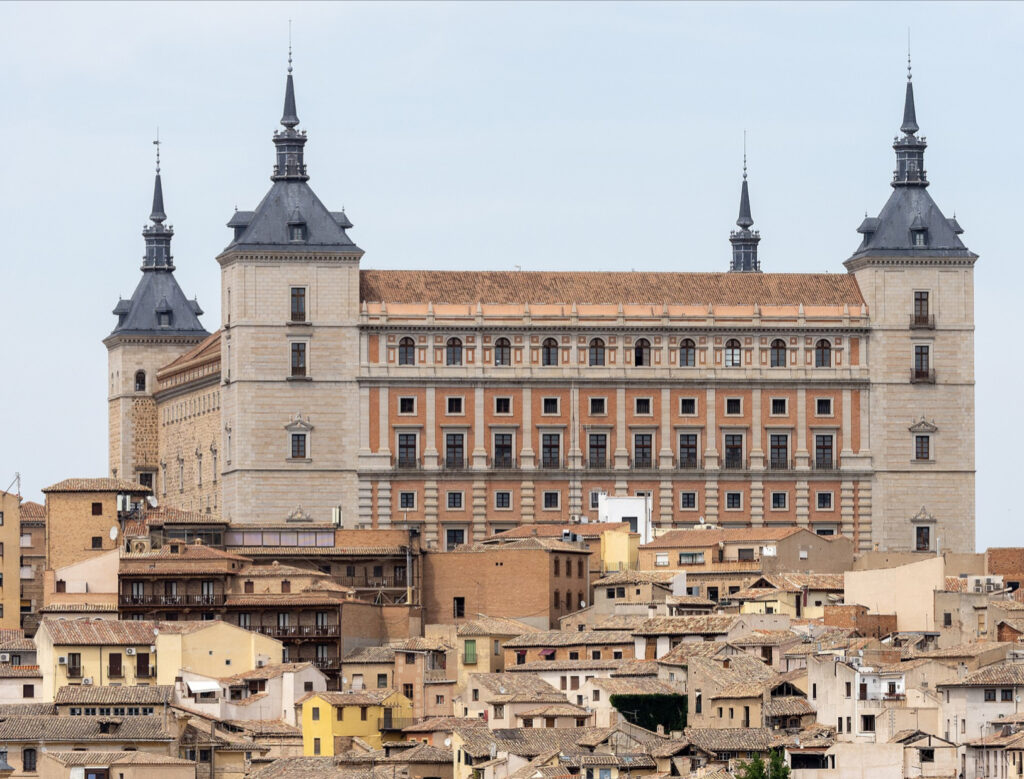
- Puerta de Bisagra
- Description: The main entrance to the city, originally of Muslim origin and rebuilt in the 16th century.
- Highlights: Grand arches, imperial coat of arms of Charles V, and impressive towers.
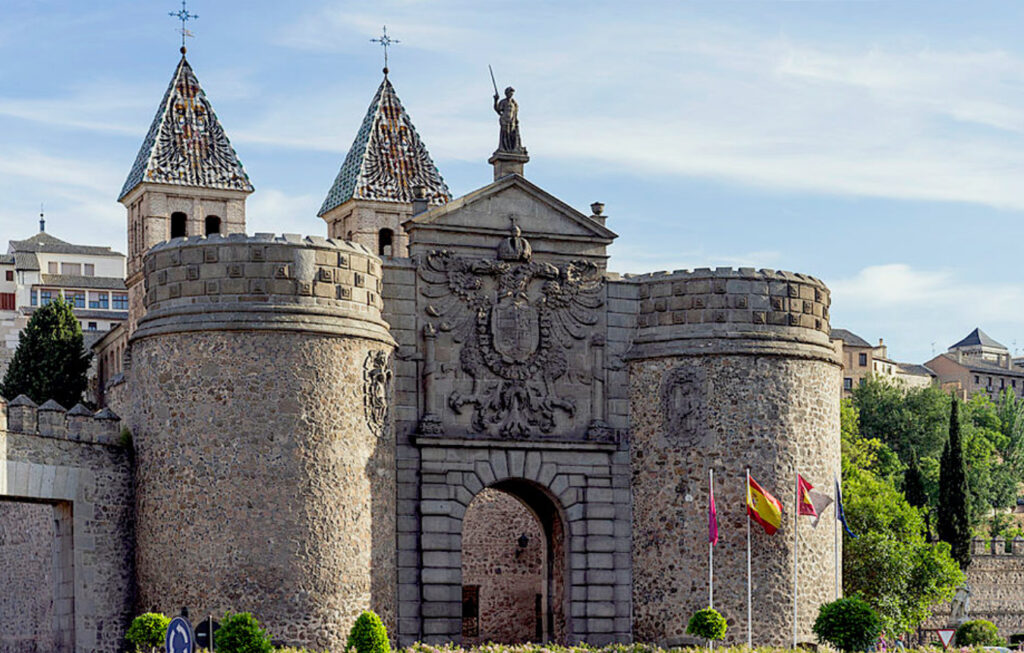
- Puerta del Sol
- Description: A 14th-century Mudéjar city gate built by the Knights Hospitaller.
- Highlights: Ornate facade, Gothic and Mudéjar elements, and historical significance.
- Castillo de San Servando
- Description: A medieval castle overlooking the Tagus River, initially a monastery and later a fortress.
- Highlights: Military architecture, scenic views, and occasional cultural events.
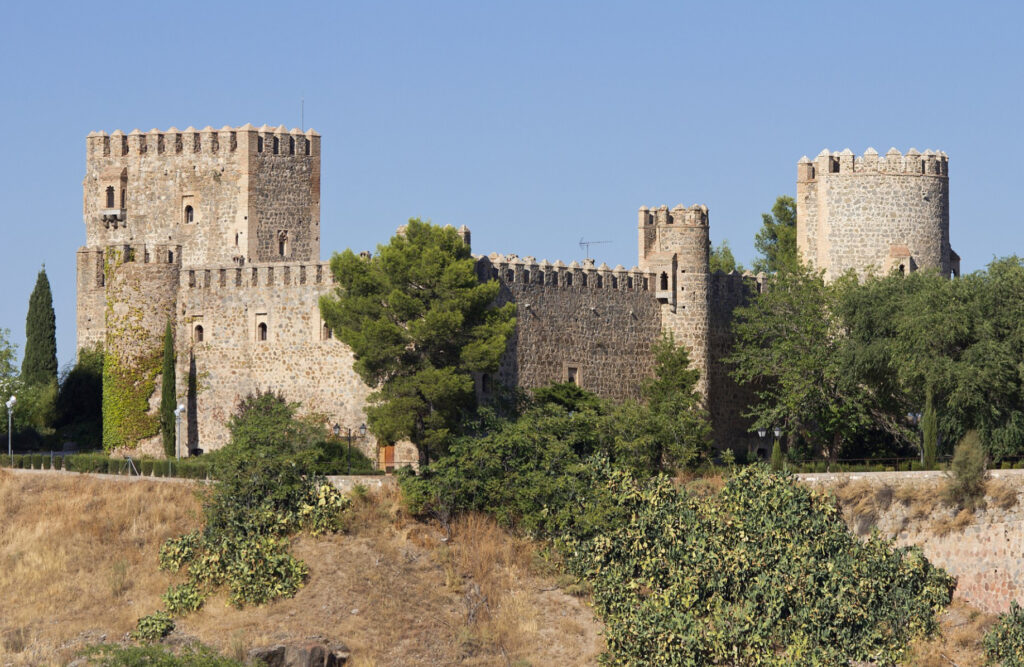
Bridges
- Puente de Alcántara
- Description: An ancient Roman bridge spanning the Tagus River, serving as a main entrance to the city.
- Highlights: Roman foundations, medieval towers, and stunning river views.
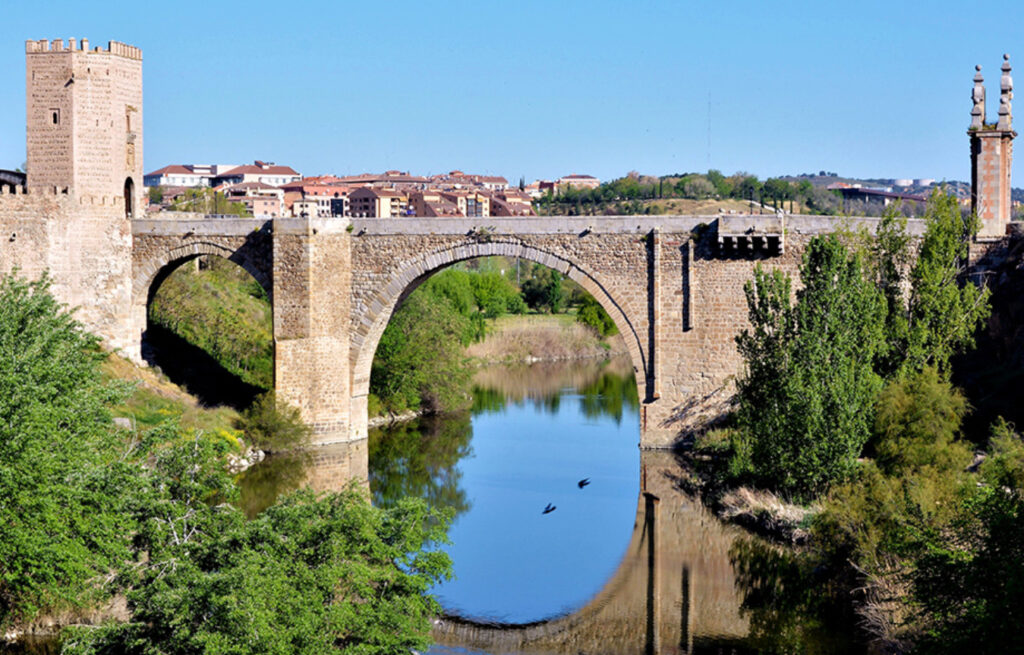
- Puente de San Martín
- Description: A medieval bridge known for its five arches and defensive towers.
- Highlights: Offers picturesque views of Toledo’s skyline and the river gorge.
Museums and Cultural Sites
- El Greco Museum
- Description: Dedicated to the life and works of the renowned painter who made Toledo his home.
- Highlights: Collection of El Greco’s paintings, period furnishings, and a recreation of a 16th-century Toledo home.
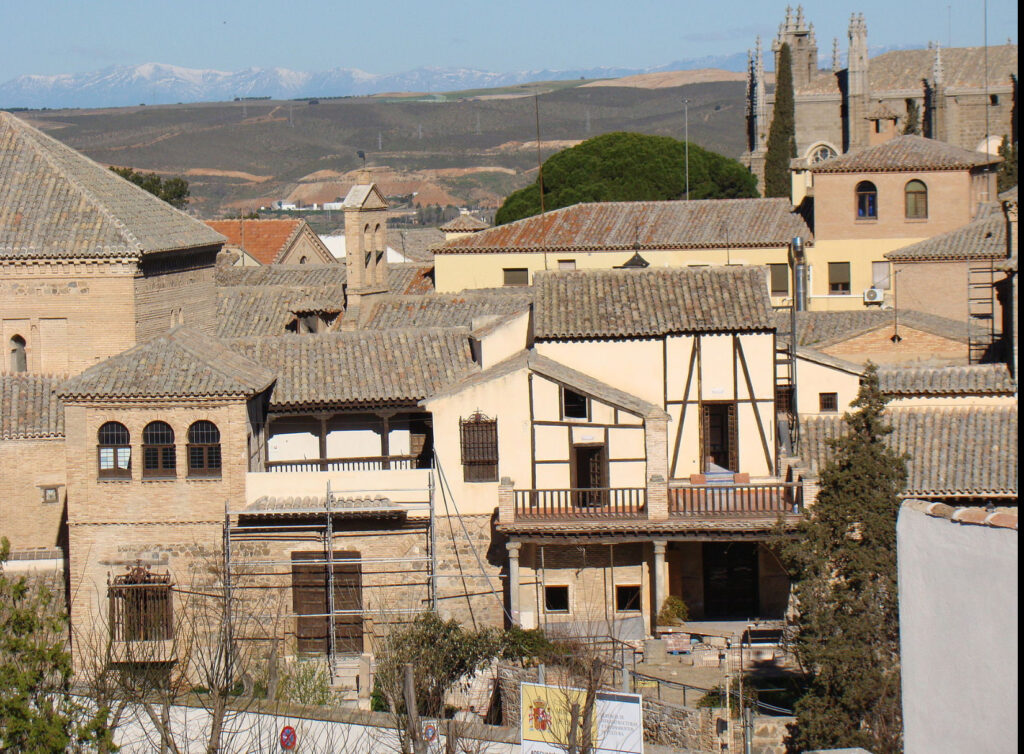
- Museo de Santa Cruz
- Description: Housed in a 16th-century hospital building, the museum showcases a diverse collection of art and archaeology.
- Highlights: Fine arts, Roman and Visigothic artifacts, and temporary exhibitions.
- Museum of the Councils and Visigothic Culture (Church of San Román)
- Description: Located in a Mudéjar church, the museum focuses on Visigothic art and history.
- Highlights: Frescoes, ancient artifacts, and insights into early medieval Spain.
- Museum of Victorio Macho
- Description: Showcases the works of the famous Spanish sculptor Victorio Macho.
- Highlights: Sculptures, drawings, and a garden with views of the Tagus River.
- Museo del Queso Manchego
- Description: A museum dedicated to the famous Manchego cheese from the La Mancha region.
- Highlights: Cheese-making exhibits, tastings, and regional wine pairings.
Public Squares and Streets
- Plaza de Zocodover
- Description: The main square and social hub of Toledo, historically a marketplace.
- Highlights: Lively atmosphere, cafés, shops, and starting point for exploring the city.
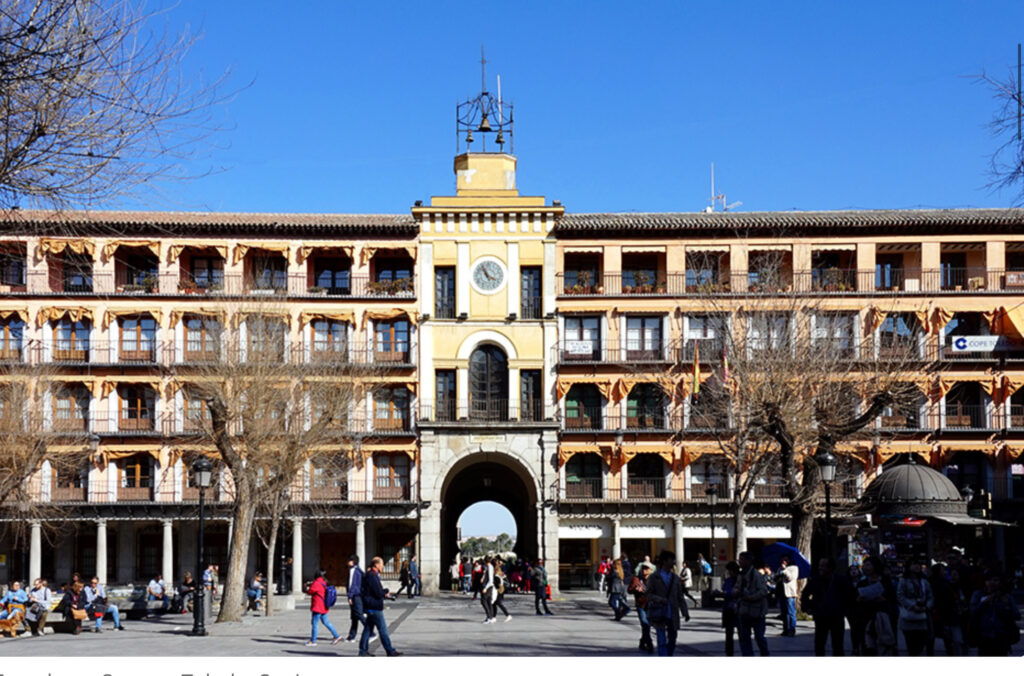
- Calle Comercio
- Description: A bustling street lined with shops selling local crafts, souvenirs, and traditional goods.
- Highlights: Artisan workshops, Toledo’s famous marzipan shops, and sword-makers.
Other Notable Sites
- Mirador del Valle
- Description: A panoramic viewpoint across the Tagus River offering breathtaking views of Toledo.
- Highlights: Ideal for photography and appreciating the city’s layout and landmarks.
- Cueva de Hércules
- Description: An archaeological site linked to Roman and Visigothic times, shrouded in local legends.
- Highlights: Ancient water cisterns and mythological associations.
- Hospital de Tavera (Museum-Hospital of Tavera)
- Description: A Renaissance-style building serving as a hospital and pantheon for the aristocracy.
- Highlights: Art gallery with works by El Greco and Ribera, a beautiful chapel, and a pharmacy museum.
- Rojas Theater (Teatro de Rojas)
- Description: A 19th-century theater named after playwright Francisco de Rojas.
- Highlights: Neoclassical architecture and a venue for cultural performances.
Traditional Crafts and Workshops
- Damascene Metalwork Shops
- Description: Toledo is famous for damascening—the art of inlaying gold or silver into steel.
- Highlights: Workshops where you can see artisans at work and purchase intricate jewelry and decorative items.
- Sword-Making Workshops
- Description: Continuing a tradition dating back to Roman times, Toledo’s sword-makers produce high-quality blades.
- Highlights: Demonstrations of forging techniques and a variety of swords and knives for purchase.
Parks and Gardens
- Jardines de la Vega
- Description: A public park perfect for relaxation amidst greenery.
- Highlights: Play areas, fountains, and sculptures.
- Tagus River Walks
- Description: Scenic paths along the riverbank.
- Highlights: Nature views, picnic spots, and opportunities for leisurely walks.
Festivals and Events Locations
- Corpus Christi Procession Route
- Description: Toledo’s most important festival, with streets adorned for the procession.
- Highlights: Elaborate decorations, religious ceremonies, and cultural activities.
Culinary Attractions
- Local Restaurants and Taverns
- Description: Experience traditional Castilian cuisine.
- Highlights: Dishes like carcamusas (pork stew), marzipan, and regional wines.
These monuments and attractions offer a deep dive into Toledo’s rich history and cultural tapestry. Whether you’re interested in architecture, art, history, or traditional crafts, Toledo provides a multifaceted experience that captivates visitors from around the world.
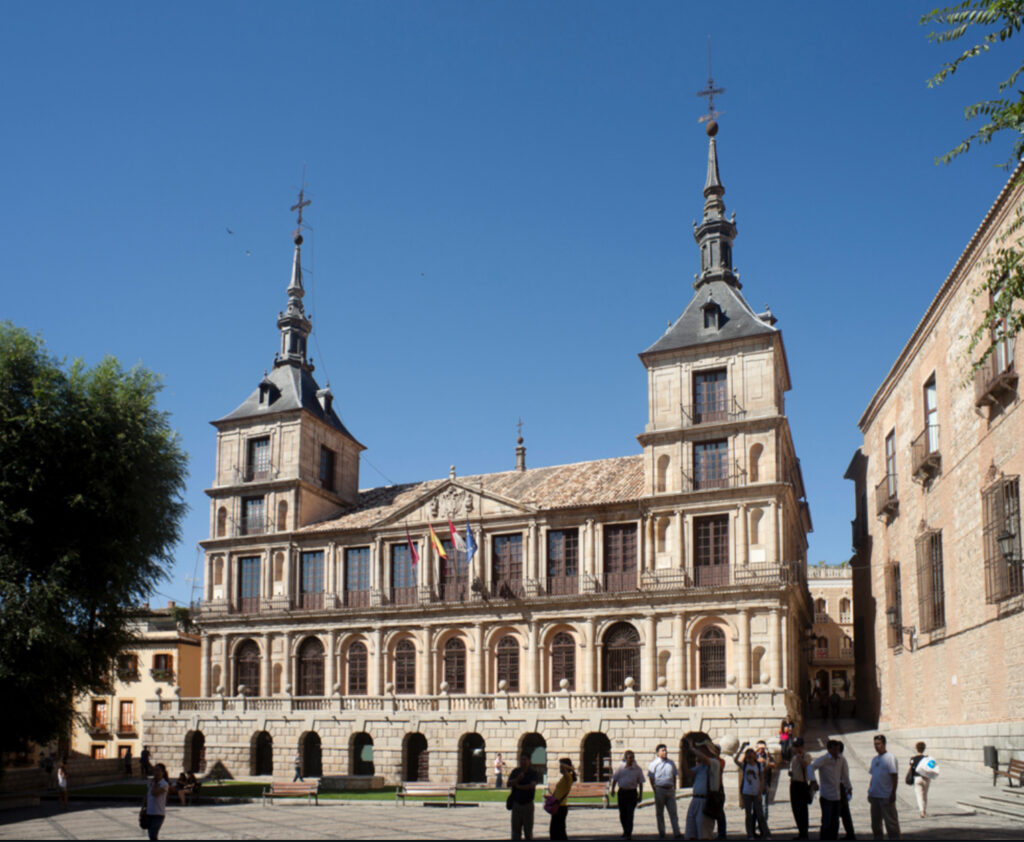
One-Day Itinerary for Visiting Toledo, Incorporating Local Food Specialties
Toledo is a city rich in history, culture, and culinary delights. This one-day itinerary will help you experience the best of Toledo’s landmarks while savoring its traditional cuisine.
Morning
9:00 AM – Start at Puerta de Bisagra
- Description: Begin your day entering the city through the impressive Puerta de Bisagra, the main gate to Toledo, showcasing the city’s Moorish influences.
- Tip: Take a moment to admire the coat of arms of Charles V above the archway.
9:15 AM – Breakfast at Plaza de Zocodover
- Local Specialty: Enjoy a traditional Spanish breakfast of chocolate con churros at a café in the bustling Plaza de Zocodover.
- Why: This sweet treat will give you energy for the morning ahead.
9:45 AM – Visit Toledo Cathedral
- Duration: Approximately 1.5 hours.
- Description: Explore the Primate Cathedral of Saint Mary of Toledo, a stunning example of Spanish Gothic architecture.
- Highlights:
- Main Chapel (Capilla Mayor): Admire the richly decorated altar.
- Sacristy: View artworks by El Greco, Goya, and Velázquez.
- Treasury: Don’t miss the gold-plated Monstrance of Arfe.
11:30 AM – Church of Santo Tomé
- Duration: 30 minutes.
- Description: Visit this Mudéjar church famous for housing El Greco’s masterpiece, “The Burial of the Count of Orgaz.”
- Tip: Observe how El Greco blended earthly and heavenly realms in his painting.
12:15 PM – Explore the Jewish Quarter
- Sites to Visit:
- Synagogue of Santa María la Blanca
- Description: Originally a synagogue, this monument exemplifies Mudéjar architecture.
- Highlights: Striking white arches and serene ambiance.
- Stroll the Streets
- Description: Wander through cobblestone lanes filled with artisan shops.
- Local Crafts: Look for damascene metalwork and traditional swords.
Lunch (1:00 PM – 2:30 PM)
Dine at a Traditional Tavern in the Jewish Quarter
- Suggested Dishes:
- Carcamusas: A hearty pork and vegetable stew, a local favorite.
- Perdiz Estofada: Stewed partridge, showcasing Toledo’s game cuisine.
- Manchego Cheese: Sample different ages of this famous regional cheese.
- Dessert:
- Marzipan de Toledo: Indulge in this almond-based sweet, a city specialty.
- Beverage:
- Local Wine: Pair your meal with a glass of Castilian red wine.
Afternoon
2:45 PM – Monastery of San Juan de los Reyes
- Duration: 1 hour.
- Description: Visit this stunning Franciscan monastery commissioned by the Catholic Monarchs.
- Highlights:
- Cloisters: Walk through the peaceful, two-tiered cloisters.
- Architectural Details: Note the intricate Gothic and Mudéjar designs.
- Chains on the Façade: Symbolizing Christians freed from Moorish captivity.
4:00 PM – Alcázar of Toledo
- Duration: 1.5 hours.
- Description: Explore this imposing fortress perched atop the highest point in Toledo.
- Highlights:
- Army Museum: Discover military history from ancient times to the present.
- Panoramic Views: Enjoy sweeping vistas of the city and the Tagus River.
5:30 PM – El Greco Museum
- Duration: 1 hour.
- Description: Delve into the life and works of El Greco, who spent much of his life in Toledo.
- Highlights:
- Art Collection: See original paintings and learn about his unique style.
- Recreated Spaces: Experience a 16th-century Toledo home.
Evening
6:45 PM – Walk to Mirador del Valle
- Transportation: Take a short taxi ride or a leisurely walk (approximately 30 minutes) to the viewpoint.
- 7:15 PM – Sunset at Mirador del Valle
- Description: Witness a breathtaking panoramic view of Toledo as the sun sets.
- Tip: This is a perfect photo opportunity to capture the city’s silhouette.
8:00 PM – Dinner Overlooking the Tagus River
- Restaurant Selection: Choose a riverside restaurant to continue enjoying the view.
- Suggested Dishes:
- Trucha a la Toledana: Trout from the Tagus River prepared with garlic and ham.
- Cochinillo Asado: Roasted suckling pig, a Castilian delicacy.
- Dessert:
- Miguelitos: Light puff pastries filled with cream.
- Beverage:
- Locally Produced Wine: Try a white wine from the nearby La Mancha region.
Night
9:30 PM – Evening Stroll Through Historic Streets
- Route: Make your way back into the city through the Puente de San Martín.
- Highlights:
- Illuminated Monuments: See landmarks like the cathedral and Alcázar beautifully lit.
- Atmosphere: Enjoy the enchanting ambiance of Toledo at night.
10:00 PM – Optional Nighttime Guided Tour
- Description: Join a tour focusing on Toledo’s legends and mysteries.
- Benefits:
- Stories: Learn about historical tales, local myths, and hidden secrets.
- Access: Some tours offer entry to underground sites or lesser-known corners.
Additional Tips
- Footwear: Wear comfortable shoes suitable for cobblestone streets and uneven terrain.
- Reservations: Consider booking museum tickets and restaurant reservations in advance.
- Shopping: Allocate time to shop for damascene jewelry, swords, or marzipan to take home.
- Local Customs:
- Siesta Time: Be aware that some shops may close in the early afternoon.
- Dining Hours: Spaniards typically dine later; restaurants may open for dinner around 8:00 PM.
By following this itinerary, you’ll immerse yourself in the rich history and culture of Toledo while savoring its gastronomic specialties. Enjoy your visit!
